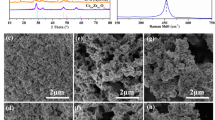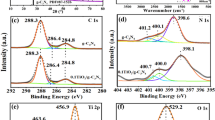Abstract
The abused ciprofloxacin antibiotics have caused significant environmental damage. Although oxidative degradation of ciprofloxacin exhibits promising efficacy, it often entails excessive energy consumption. Hence, it is necessary to explore an effective and ecologically sustainable degradation strategy. Herein, we demonstrated that g-C3N4 decorated with the coordinated CeO2 and Co3O4 (CeO2-Co3O4/CN) exhibited effective ciprofloxacin photodegradation via in situ H2O2 production and activation mechanism. Results indicate that the introduced CeO2 enhances the transference of photogenerated electrons to O2 by adjusting the oxygen vacancy of photocatalyst, thereby increasing the generation of superoxide radicals, which in turn generate H2O2, resulting in a 22.4-fold increase in H2O2 generation over g-C3N4. Moreover, the in situ H2O2 generation facilitated by CeO2 is confirmed to be essential for ciprofloxacin degradation via CeO2-Co3O4/CN, as it provides enough oxidant for Co3O4 to activate into hydroxyl radicals for the pollutants degradation. Ultimately, CeO2-Co3O4/CN achieves a ciprofloxacin degradation ratio of 97.7% within 80 min. This study introduces a novel approach that combines H2O2 generation and activation, offering an innovative perspective for achieving clean and efficient purification of antibiotic-contaminated water.
Graphical abstract

摘要
环丙沙星(CIP)一类抗生素的滥用对环境造成了严重的危害, 而氧化降解CIP虽然效果明显但通常会产生较高能耗, 所以探究一种高效清洁的降解方法迫在眉睫。本研究提出以氮化碳为光敏载体, 通过在其表面负载和协调CeO2和Co3O4两种活性组分, 最终成功合成能够串联H2O2生成和活化反应的光催化剂(CeO2-Co3O4/CN), 并达到高效降解CIP的目的。结果表明, 得益于CeO2能够富集光生电子的性质及其自身对氧气的吸附能力, 催化剂的H2O2生成效果比氮化碳提高了22.41倍, 并证实上述CeO2特性是复合材料能够高效降解污染物的关键因素。此外, 负载Co3O4则有利于高效活化生成的H2O2, 并且证实了CeO2-Co3O4/CN能够协调进行这两步反应, 最终在80 min内达到97.7%的CIP降解率。本研究提出了一种串联H2O2生成反应和活化反应的新方法, 为清洁高效降解水中抗生素提供了一种新的思路。








Similar content being viewed by others
References
Yin S, Wang J, Tong Q, Jiang X, Lu P, Zhu Q, Zhang Q, Zhang Z, Ueda W. Degradation of ciprofloxacin with hydrogen peroxide catalyzed by ironmolybdate-based zeolitic octahedral metal oxide. Appl Catal A. 2021;626:118375. https://doi.org/10.1016/j.apcata.2021.118375.
Bronzato JD, Brito AMM, Bettini J, Passini MRZ, Gomes BPFA, Nantes IL. Degradation of ciprofloxacin by green cobalt oxide quantum dots. Appl Surf Sci. 2023;609:155193. https://doi.org/10.1016/j.apsusc.2022.155193.
Fan G, Cai C, Yang S, Du B, Luo J, Chen Y, Lin X, Li X, Wang Y. Sonophotocatalytic degradation of ciprofloxacin by Bi2MoO6/FeVO4 heterojunction: insights into performance, mechanism and pathway. Sep Purif Technol. 2022;303:122251. https://doi.org/10.1016/j.seppur.2022.122251.
Orimolade BO, Zwane BN, Koiki BA, Tshwenya L, Peleyeju GM, Mabuba N, Zhou M, Arotiba OA. Solar photoelectrocatalytic degradation of ciprofloxacin at a FTO/BiVO4/MnO2 anode: kinetics, intermediate products and degradation pathway studies. J Environ Chem Eng. 2020;8:103607. https://doi.org/10.1016/j.jece.2019.103607.
Jimenez-Salcedo M, Monge M, Tena MT. Study of intermediate by-products and mechanism of the photocatalytic degradation of ciprofloxacin in water using graphitized carbon nitride nanosheets. Chemosphere. 2020;247:125910. https://doi.org/10.1016/j.chemosphere.2020.125910.
Yu X, Zhang J, Zhang J, Niu J, Zhao J, Wei Y, Yao B. Photocatalytic degradation of ciprofloxacin using Zn-doped Cu2O particles: analysis of degradation pathways and intermediates. Chem Eng J. 2019;374:316. https://doi.org/10.1016/j.cej.2019.05.177.
Wang D, Yin FX, Cheng B, Xia Y, Yu JG, Ho WK. Enhanced photocatalytic activity and mechanism of CeO2 hollow spheres for tetracycline degradation. Rare Met. 2021;40(9):2369. https://doi.org/10.1007/s12598-021-01731-2.
Huang Z, Huang F, Tian J. Progresses in CuInSe2 quantum dots: synthesis and optoelectronic applications. Chin J Rare Met. 2022;46(6):695. https://doi.org/10.13373/j.cnki.cjrm.XY22010013.
Zhu C, Yao H, Sun T, Le S, Jin Q, Chen C, Xu H, Wang S. Ultrathin fluorine-doped TiO2(b) nanosheets-anchored hierarchical cog wheel-shaped NH2-mil-53(Al) for boosting photocatalytic activity. Chem Eng J. 2023;460:141849. https://doi.org/10.1016/j.cej.2023.141849.
Pan L, Shi W, Sen T, Wang L, Zhang J. Visible light-driven selective organic degradation by FeTiO3/persulfate system: the formation and effect of high valent Fe(IV). Appl Catal B. 2021;280:119414. https://doi.org/10.1016/j.apcatb.2020.119414.
Li JY, Wang XY, Tian J, Zhang XL, Shi F. Co–Fe quantum dots coupled with ultrathin g-C3N4 nanosheets as efficient and stable photo-Fenton catalysts. Rare Met. 2023;42(6):1877. https://doi.org/10.1007/s12598-022-02226-4.
Zhu H, Li M, Zou L, Hu Y, Hao H, Dou J, Mao J. A study on singlet oxygen generation for tetracycline degradation via modulating the size of α-Fe2O3 nanoparticle anchored on g-C3N4 nanotube photocatalyst. Nano Res. 2022;16:2236. https://doi.org/10.1007/s12274-022-5015-x.
Feng C, Tang L, Deng Y, Wang J, Liu Y, Ouyang X, Yang H, Yu J, Wang J. A novel sulfur-assisted annealing method of g-C3N4 nanosheet compensates for the loss of light absorption with further promoted charge transfer for photocatalytic production of H2 and H2O2. Appl Catal B. 2021;281:119539. https://doi.org/10.1016/j.apcatb.2020.119539.
Xu J, Zheng X, Feng Z, Lu Z, Zhang Z, Huang W, Li Y, Vuckovic D, Li Y, Dai S. Organic wastewater treatment by a single-atom catalyst and electrolytically produced H2O2. Nat Sustain. 2021;4:233. https://doi.org/10.1038/s41893-020-00635-w.
Wang YH, Mondal B, Stahl SS. Molecular cobalt catalysts for O2 reduction to H2O2: benchmarking catalyst performance via rate–overpotential correlations. ACS Catal. 2020;10:12031. https://doi.org/10.1021/acscatal.0c02197.
Chen L, Wang L, Wan Y, Zhang Y, Qi Z, Wu X, Xu H. Acetylene and diacetylene functionalized covalent triazine frameworks as metal-free photocatalysts for hydrogen peroxide production: a new two-electron water oxidation pathway. Adv Mater. 2020;32:e1904433. https://doi.org/10.1002/adma.201904433.
Yang L, Dong G, Jacobs DL, Wang Y, Zang L, Wang C. Two-channel photocatalytic production of H2O2 over g-C3N4 nanosheets modified with perylene imides. J Catal. 2017;352:274. https://doi.org/10.1016/j.jcat.2017.05.010.
Cai J, Huang J, Wang S, Iocozzia J, Sun Z, Sun J, Yang Y, Lai Y, Lin Z. Crafting mussel-inspired metal nanoparticle-decorated ultrathin graphitic carbon nitride for the degradation of chemical pollutants and production of chemical resources. Adv Mater. 2019;31:e1806314. https://doi.org/10.1002/adma.201806314.
Tang D, Shao C, Jiang S, Sun C, Song S. Graphitic C2N3: an allotrope of g-C3N4 containing active azide pentagons as metal-free photocatalyst for abundant H2 bubble evolution. ACS Nano. 2021;15:7208. https://doi.org/10.1021/acsnano.1c00477.
Dong Y, Ma A, Li J, Li H, Gao Y. Preparation of defective g-C3N4 nanosheets by thermal exfoliation and its photocatalytic performance. Chin J Rare Met. 2021;45(1):47. https://doi.org/10.13373/j.cnki.cjrm.xy19060009.
Zheng K, Li Y, Liu B, Jiang F, Xu Y, Liu X. Ti-doped CeO2 stabilized single-atom rhodium catalyst for selective and stable CO2 hydrogenation to ethanol. Angew Chem Int Ed. 2022;61:e202210991. https://doi.org/10.1002/anie.202210991.
Huang X, Zhang K, Peng B, Wang G, Muhler M, Wang F. Ceria-based materials for thermocatalytic and photocatalytic organic synthesis. ACS Catal. 2021;11:9618. https://doi.org/10.1021/acscatal.1c02443.
Ye J, Jing M, Liang Y, Li W, Zhao W, Huang J, Lai Y, Song W, Liu J, Sun J. Structure engineering of CeO2 for boosting the Au/ CeO2 nanocatalyst in the green and selective hydrogenation of nitrobenzene. Nanoscale Horizons. 2023;8:812. https://doi.org/10.1039/d3nh00103b.
Zhou P, Hai G, Zhao G, Li R, Huang X, Lu Y, Wang G. CeO2 as an “electron pump” to boost the performance of Co4N in electrocatalytic hydrogen evolution, oxygen evolution and biomass oxidation valorization. Appl Catal B. 2023;325:122364. https://doi.org/10.1016/j.apcatb.2023.122364.
Li M, Li W, Yang Y, Yu D, Lin J, Wan R, Zhu H. Remarkably efficient Pt/CeO2–Al2O3 catalyst for catalytic hydrodeiodination of monoiodoacetic acid: synergistic effect of Al2O3 and CeO2. Chemosphere. 2023;327:138515. https://doi.org/10.1016/j.chemosphere.2023.138515.
Hao X, Xiang D, Jin Z. Amorphous Co3O4 quantum dots hybridizing with 3D hexagonal CdS single crystals to construct a 0D/3D P-N heterojunction for a highly efficient photocatalytic H2 evolution. Dalton Trans. 2021;50:10501. https://doi.org/10.1039/d1dt01333e.
Wang S, Zhu B, Liu M, Zhang L, Yu J, Zhou M. Direct Z-scheme ZnO/CdS hierarchical photocatalyst for enhanced photocatalytic H2-production activity. Appl Catal B. 2019;243:19. https://doi.org/10.1016/j.apcatb.2018.10.019.
Lu T, Chen F. Multiwfn: a multifunctional wavefunction analyzer. J Comput Chem. 2012;33:580. https://doi.org/10.1002/jcc.22885.
Salma A, Thoroe-Boveleth S, Schmidt TC, Tuerk J. Dependence of transformation product formation on pH during photolytic and photocatalytic degradation of ciprofloxacin. J Hazard Mater. 2016;313:49. https://doi.org/10.1016/j.jhazmat.2016.03.010.
Gupta A, Garg A. Degradation of ciprofloxacin using Fenton’s oxidation: effect of operating parameters, identification of oxidized by-products and toxicity assessment. Chemosphere. 2018;193:1181. https://doi.org/10.1016/j.chemosphere.2017.11.046.
Borba FH, Schmitz A, Pellenz L, Bueno F, Kasper N, Wenzel BM, Baroni S, Dall’Oglio IC, Módenes AN. Genotoxicity and by-products assessment in degradation and mineralization of ciprofloxacin by UV/H2O2 process. J Environ Chem Eng. 2018;6:6979. https://doi.org/10.1016/j.jece.2018.10.068.
Liu C, Nanaboina V, Korshin GV, Jiang W. Spectroscopic study of degradation products of ciprofloxacin, norfloxacin and lomefloxacin formed in ozonated wastewater. Water Res. 2012;46:5235. https://doi.org/10.1016/j.watres.2012.07.005.
Acknowledgements
This study was financially supported by Shandong Provincial Natural Science Foundation (No. ZR2021QB123), Liaocheng University Start-up Fund for Doctoral Scientific Research (No. 318052017) and the Open Fund of State Key Lab of Pollution Control and Resource Reuse Research, China (No. PCRRF20002). We would like to thank Liaocheng YiLu Advanced Materials Co. Ltd for assistance in photocatalyst synthesis and language editing.
Author information
Authors and Affiliations
Corresponding author
Ethics declarations
Conflict of interests
The authors declare that they have no conflict of interest.
Supplementary Information
Below is the link to the electronic supplementary material.
Rights and permissions
Springer Nature or its licensor (e.g. a society or other partner) holds exclusive rights to this article under a publishing agreement with the author(s) or other rightsholder(s); author self-archiving of the accepted manuscript version of this article is solely governed by the terms of such publishing agreement and applicable law.
About this article
Cite this article
Zhu, HJ., Yang, YK., Li, MH. et al. Photocatalytic in situ H2O2 production and activation for enhanced ciprofloxacin degradation over CeO2-Co3O4/g-C3N4: key role of CeO2. Rare Met. 43, 2695–2707 (2024). https://doi.org/10.1007/s12598-023-02583-8
Received:
Revised:
Accepted:
Published:
Issue Date:
DOI: https://doi.org/10.1007/s12598-023-02583-8




